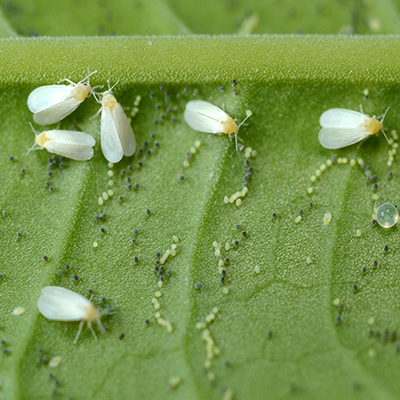Whitefly (Aleyrodidae)

The adult Glasshouse Whitefly holds its wings in a tent-like fashion over the body, hiding the body and giving it a triangular outline. This is in contrast to Bemisia tabaci, adults of which hold the wings alongside the body, revealing the yellow body colour and giving them an elliptical profile.
Adults of T. vaporariorum generally settle on young foliage close to the growing point of the plant, and lay eggs there. Eggs are creamy white in colour when first laid, but turn black within 24 hours. The larvae that hatch are initially mobile, and are known as ‘crawlers’. These soon settle, and the rest of the larval stages are immobile. In rapidly growing plants such as commercially grown tomatoes, this often leads to a stratification of whitefly ages on the plant, with adults and eggs at the top, young larvae a little lower, larger larvae towards the middle of the plant, and pupae towards the base.
Feeding larvae draw sap from the plant, extract proteins and other nutrients, and excrete the surplus sugars, which are present in the sap as ‘honeydew’. At high populations, the copious honeydew produced leads to the leaves or fruit becoming sticky, and to the growth of sooty moulds which restrict photosynthesis, and are unsightly. Trialeurodes vaporariorum can also transmit some virus diseases to plants, but is less important in this respect than Bemisia tabaci.
Development is temperature dependent, and may also vary with the crop and cultivar. Some example figures are shown below
DURATION OF DEVELOPMENT OF DIFFERENT WHITEFLY STAGES AT 21-23°C
| STAGE | EGG | 1ST INSTAR | 2ND INSTAR | 3RD INSTAR | 4TH INSTAR | ‘PUPA’ |
|---|---|---|---|---|---|---|
| Duration in days | 8 | 6 | 2 | 3 | 4 | 5 |
TOTAL DURATION OF DEVELOPMENT OF TRIALEURODES AT DIFFERENT TEMPERATURES
| 12°C | 15°C | 18°C | 21°C | 24°C | 30°C |
|---|---|---|---|---|---|
| 113 | 68 | 40 | 28 | 23 | 20 |
